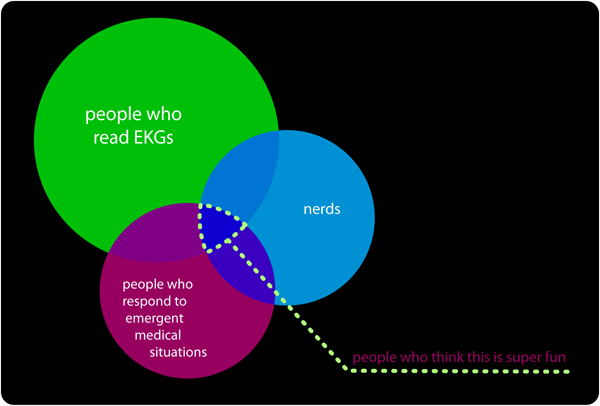The Short Story:
Pick a case (from the case list). It’s best to start with case 1 and go in sequence.
You get 15 seconds to form an impression. Then see what gives. If you don’t want to read any discussion, skim down to “final impression” to see the final interpretation.
Click ‘next case’ at the bottom of each page to move on to the next one.
The Long Story:
StripTease is aimed at providers who need to make fast interpretations of critical care monitoring equipment. This is primarily aimed at on-call inpatient residents, paramedics, flight nurses, rapid response teams, and other providers who need to move fast.
The focus is on EKG interpretation- generally of a single lead as would be presented on a bedside monitor, a defibrillator, an alarm strip, etc. However, the cases included here often include other data such as invasive blood pressures, respiratory tracings, etc. These, as in the real world, compliment the EKG.
Also, as in the real world, imperfect tracings are standard fare here. There are many tracings with heavy artifact, because sometimes artifact is a big part of the interpretation. Either you need to read through it to correctly make the diagnosis, or perhaps the artifact is the only abnormality and you need to differentiate it from pathologic findings, thereby sparing some unnecessary fuss.
Finally- as in the real world, you often will not be able to definitively tell what you are seeing on the strip. Is it MAT or afib? VT or aberrancy? The point is not to always be definitive from these quick reads. The point is to maximize the information that you can glean from the strip.
To that end, the site tries to pull off two very different goals.
First: to provide practice problems so as to get better at making rapid interpretations. In a situation with a very ill patient you need to move quickly, and in an effort to push you there is a generally a 15s time limit on the initial read. Most strips will require more time than that to fully unpack, but by the end of the 15 seconds you should attempt to have a gestalt.
The most important initial thoughts is “What are the expected hemodynamic consequences (if any) of this rhythm?”.
Decide: Does this strip show something I need to act on immediately?
Check pulse and start compressions? Attach pads? Push calcium?
Assess for lead artifact?
Is this unremarkable and something else must be going on?
Second: to allow some slow and thoughtful dissection of whatever can be gleaned from the strip, for the sake of learning and discussion.
This is like playing chess to prepare for checkers.
Maybe you dont play chess. Your game is checkers. But if you learn to play chess, work some problems, learn some good moves, develop a system, become facile.. then think how easy it is going to be to crush your next checkers match (at 4:00am when the code pager goes off). When arrhythmias feel easy at the bedside it will free your neurons to work on all the other hard things happening simultaneously.
Need motivation?
Imagine yourself on the night shift. Its busy. You are paged for a rapid response for your patient and run in with your senior. She is checking the ABCs, and a float nurse with big scared eyes that you’ve never met before hands you some paper. “There is something wrong with your patient. Here’s the strip.”
Or maybe you’re a medic. Your EMT-B is doing the primary assessment and this is what comes up in the first fifteen seconds on the monitor. Put yourself there and it’s more fun.
Note to medics.. StripTease is not an ACLS review site. These strips and their discussion are far and away more complex than what is expected of you to answer those 25 silly questions every couple years. But- it’s all relevant. Train hard and the fight feels easy.

Try hard to have a next step in mind when the time is up. Then sit back, relax, pore over the interpretation, and then if you disagree or want to chime in- pipe up! Some of these are tough as nails and my ‘official’ read might be bullsh*t. Some of these don’t necessarily have only one answer. Of course there are none of the situational cues here- I’m not putting up pictures of the patient, vitals (that aren’t on the strip itself), nor history and physical. It’s an imperfect dry run, but we stand to learn something.
Thanks for coming-
Anthony
8,447 total views, 2 views today